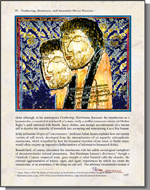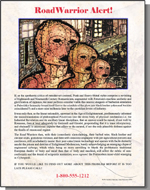
Pataphysic Sorties
Volume Three
Road Warriors and the Simulacrum
 Nathaniel Hawthorne’s famous simulacrum was a scarecrow, given breath, human appearance, and named Feathertop by a scheming old witch. It could talk and pose, and successfully woo the mayor’s daughter, but there was nothing actually real about any of
it.
Nathaniel Hawthorne’s famous simulacrum was a scarecrow, given breath, human appearance, and named Feathertop by a scheming old witch. It could talk and pose, and successfully woo the mayor’s daughter, but there was nothing actually real about any of
it.
Feathertop was a fictive copy of a human, not in the least in touch with reality. Emmanuel Kant puts us all in basically the same position as Hawthorne’s simulacrum, convincing us that we have no way to actually touch, experience, or know reality or absolute noumenal truth. He points out that everything is mediated by our biased senses and conceptualizing minds; what we experience is not reality itself. In a sense, he makes scarecrows of us all.
 Jean Beaudrillard accepts that, especially in over-conceptualized postmodern times, we are living the illusory intangible lives of scarecrows. He says we’re simulacra, living in a simulacrum, simply because we accept our conceptually-fabricated imaginations
as structures of actual reality. On Beaudrillard’s take, pretty much everything we experience is deracinated illusory conceptualization. And the extreme demonstration in Hershman-Leeson’s
I Am Not Roberta Breitmore takes this to the ground on the most basic personal level.
Jean Beaudrillard accepts that, especially in over-conceptualized postmodern times, we are living the illusory intangible lives of scarecrows. He says we’re simulacra, living in a simulacrum, simply because we accept our conceptually-fabricated imaginations
as structures of actual reality. On Beaudrillard’s take, pretty much everything we experience is deracinated illusory conceptualization. And the extreme demonstration in Hershman-Leeson’s
I Am Not Roberta Breitmore takes this to the ground on the most basic personal level.
Like many Romans in late Classical times, many disaffected people in contemporary industrial society have taken to affecting barbarian styles, such as punk, heavy metal, body piercing and decorating, etc. The Road Warrior esthetic, and all the other barbarian emulations currently favored by so many, are plainly a reaction against an over-conceptualized society, and an attempt to reconnect with unconceptualized dirt-level reality - and thus a signaled rejection of the simulacra of Kant and Beaudrillard.
 Kant of course would argue that the simulacrum cannot be avoided; it’s inherent in the human condition. Beaudrillard seems to leave the possibility open, with his implicative criticism that this is not a natural condition.
Roberta Breitmore cleverly reveals that the diametric difference is moot. We are all Roberta Breitmore.
Kant of course would argue that the simulacrum cannot be avoided; it’s inherent in the human condition. Beaudrillard seems to leave the possibility open, with his implicative criticism that this is not a natural condition.
Roberta Breitmore cleverly reveals that the diametric difference is moot. We are all Roberta Breitmore.
As Ramachandran points out, Hindu philosophy for thousands of years has understood what neuro-physiologists are finally being able to prove in laboratories: that identity is fabricated, and like perception of reality and all physical sensation, is mediated by the brain in a...
THIS BOOK IS CURRENTLY UNAVAILABLE